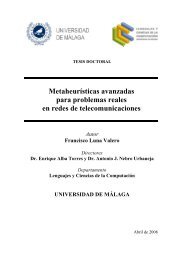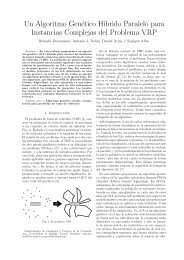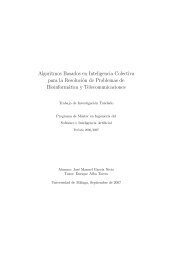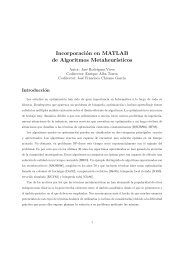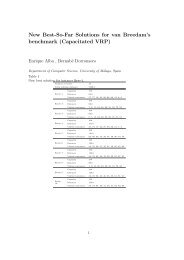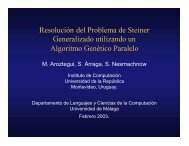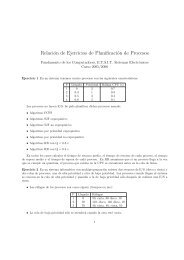Using the EPOL Library. Example GA - NEO
Using the EPOL Library. Example GA - NEO
Using the EPOL Library. Example GA - NEO
Create successful ePaper yourself
Turn your PDF publications into a flip-book with our unique Google optimized e-Paper software.
Project:<br />
Neural network training by combining evolutionary<br />
algorithms and local search<br />
Last Updated: 28/10/2002 (Málaga) Authors Dr. Enrique Alba Torres<br />
Updated: 15/10/2002 (Madrid) D. Ignacio Reyes Moreno<br />
Sequential Model<br />
The seq_model directory contains <strong>the</strong> source code and configuration files to<br />
run <strong>the</strong> NN training problem using <strong>EPOL</strong> in sequential. Before running this example, let<br />
us have a look to <strong>the</strong> required files:<br />
• xxx.param file. This file contains all <strong>the</strong> parameters needed to<br />
configurate <strong>EPOL</strong>. This file contains some sections, <strong>the</strong> most important<br />
ones are: NUMBER_OF_OPERATOR, SEED (initialize <strong>the</strong> random<br />
seed used by <strong>the</strong> <strong>GA</strong> in its randomized operations), OPERATORS,<br />
PROBLEM_CONFIG_FILE, NUMERIC_RANGES, and<br />
OUTPUT_DISPLAY. For this example we will use <strong>the</strong> file<br />
seq_decoder_ga.param<br />
• xxx.net files. As we mention above, for each NN problem to be<br />
solved in <strong>EPOL</strong> we will need 2 .net files, namely one for training and<br />
one for testing <strong>the</strong> pattern set. Our training and evaluation pattern sets for<br />
<strong>the</strong> encoded example are, respectively: OCHO383_train.net and<br />
OCHO383_test.net.<br />
• xxx.out file. This file is created every time <strong>the</strong> OUTPUT_DISPLAY<br />
section from <strong>the</strong> .param file is set to ALL. The file contains <strong>the</strong> results<br />
of a trace of execution. It’s recommended to set this param when<br />
debugging <strong>the</strong> behaviour of <strong>the</strong> EA.<br />
Now that we have presented <strong>the</strong> main files for this example, we need to<br />
implement <strong>the</strong> <strong>GA</strong> algorithm in a .cpp file using <strong>the</strong> classes and services of <strong>EPOL</strong>. To<br />
reach this goal for <strong>the</strong> NN training problem just open <strong>the</strong> file<br />
main_decoder_ga.cpp file to see how it implementes <strong>the</strong> example at hands (a<br />
simple <strong>GA</strong> that trains a NN for <strong>the</strong> encoder problem). Follow <strong>the</strong> instructions made in<br />
<strong>the</strong> comments.<br />
Once you understand completely all <strong>the</strong> files mentioned before, it’s time to<br />
compile and generate an executable file. For sequential projects, use <strong>the</strong> makefile in<br />
<strong>the</strong> directory seq_model. Write at <strong>the</strong> prompt of your system: “makefile –f<br />
ga_example”. You should have installed a g++ compiler with version greater than<br />
2.0, because we are using templates that might cause some problems in earlier versions.<br />
Now <strong>the</strong> system is ready. Just execute <strong>the</strong> file ga_decoder.exe and wait<br />
until <strong>EPOL</strong> ends. A report will be issued to your console and a result file will be<br />
generated.<br />
Authors’ note: <strong>EPOL</strong> has been designed to be executed under Linux or Unix machines with g++<br />
compiler. At this moment, we do not know of any incompatibility or bug for it.<br />
Anyway, if you detect any problem with <strong>EPOL</strong>, please, do not hesitate to write us with<br />
<strong>the</strong> error description you got. We will provide a solution to it in our Web page as soon<br />
as possible.<br />
-3-






